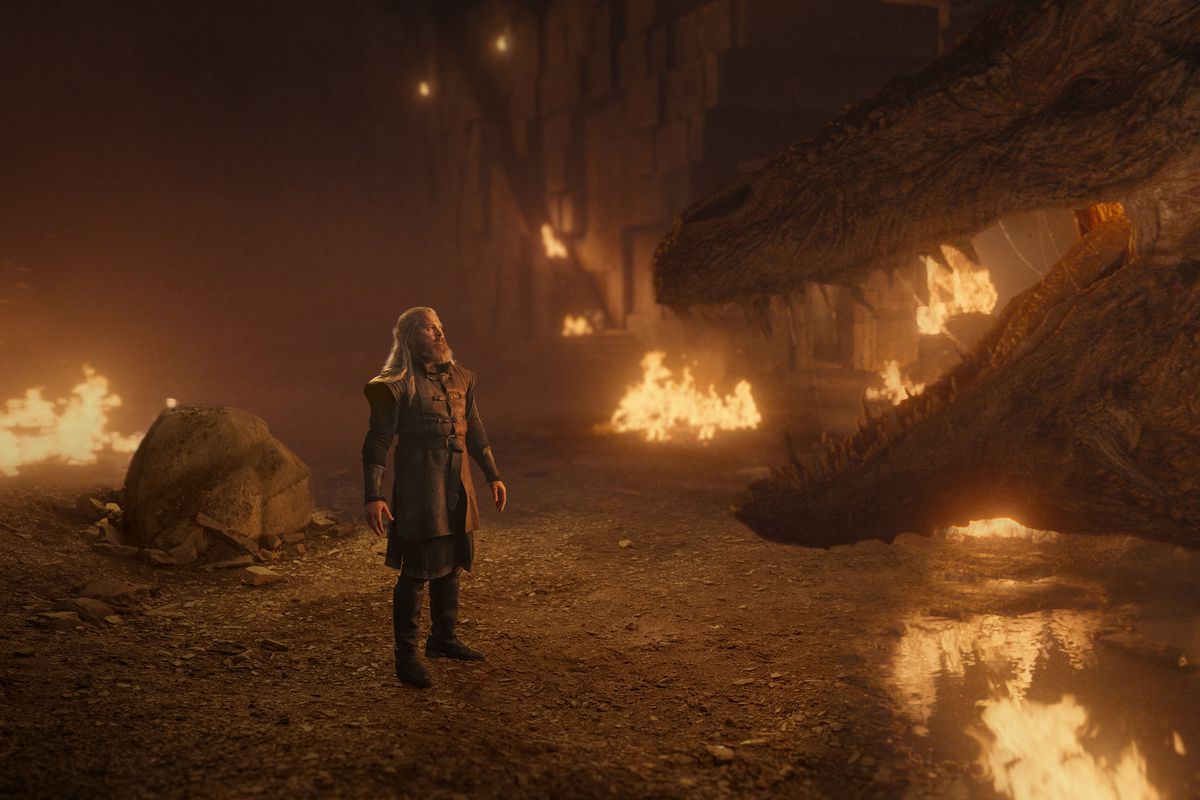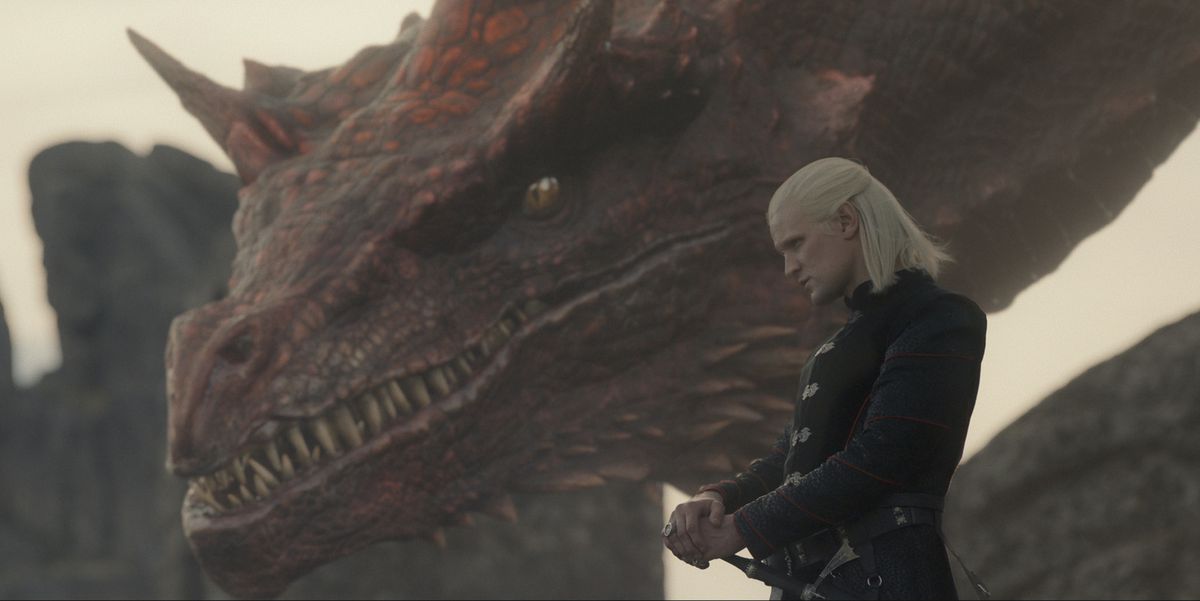House of the Dragon season 2 told a deeper story through its dragons
Midway through Season 2, Ser Criston Cole awoke on the battlefield of Rook’s Rest, bruised, battered, and possibly concussed. He sought help from a nearby soldier, pushing against his fellow man’s armor… only for the camera to reveal nothing but a skeleton inside, crumbling under Cole’s touch. The soldier had been destroyed by dragonfire, his appearance reminiscent of victims vaporized by atomic bombs.
It is a striking visualization for House of the Dragon season 2, which often presents its titular dragons as analogous to weapons of mass destruction. However, the show emphasizes that they are not merely used as weapons against external enemies. After all, dragons lend legitimacy to House Targaryen, buttressing their right to rule with the implicit threat of violence against those who color outside the lines. And yet, despite their use as fearsome weapons against enemies both within and without, dragons can also be read as tools of House Targaryen itself. House of the Dragon wants us to empathize with the animals who die in battles they did not choose. There are parallels to real-life environmental disaster in this story of a species on the brink of extinction.
To begin with, though, the nuclear analogy is crucial to understanding the series, and much of the current season shows the various players in the Targaryen civil war worrying about who’s in charge. most dragon power. Numerical advantage is presented as important, but so is the quality and scale of the dragons in Teams Green and Black’s respective arsenals. Having a dragon provides strength and protection… until someone finds a bigger dragon.
And that was a major problem for Rhaenyra this season. When the war that would come to be known as the “Dance of Dragons” broke out, the show played up its nuclear metaphor by portraying her as seriously behind in an arms race with Team Green, with her in-play dragons being outclassed by Aemond and his massive beast, Vhagar. Worse yet, the powerful dragons Rhaenyra did to which they had access, did not possess dragonriders and therefore could not be employed as the living weapons the Targaryens use.
Photo: Theo Whiteman/HBO
That’s why she has taken the measures she has taken to find dragonriders. In a move that would have serious political implications for the Seven Kingdoms, Rhaenyra accepted dragonseeds, bastards, and “lowborns” to fill her ranks. Calling upon her extended, “illegitimate” family, she proclaimed that by raising dragonriders from among them, she could bring peace and an end to suffering and bloodshed. Such is the logic of nuclear deterrence and its Westerosi, dragon-backed equivalent: whoever has the biggest stick makes the rules and provides “stability.”
This logic, however, exposes the lie underlying Rhaenyra’s proclamation. Even if the Greens surrendered in the face of her dragons, it wouldn’t mean an end to violence. It would simply mean that Rhaenyra would have a monopoly on violence. With the power of the dragons on her side, she hopes to be glorified as the unquestionable monarch. And the thing about monarchs is that they get to decide what if are violence, and also which ends justify the means. As we see in “The Red Sowingputting dozens of people at risk small people —and forcibly preventing them from escaping as they are devoured by the dragon Vermithor—is entirely justified if it means taking even one dragonrider from among them. She may feel some remorse, but all tears sound hollow in the face of these innocent civilians being burned alive by dragons that (seemingly) only the Targaryens can control.
It is through this apparent control that the royals of Westeros have convinced the peoples of the Seven Kingdoms to accept Targaryen dominance. They have done this through intimidation and, at least tacitly, by making the little people view dragons as gods (a widely held belief that has only recently been questioned, now that the little people have seen that dragons can die just like anything else). House of the Dragon reminds us that the elite (real and fictional) will always find ways to portray themselves as especially valuable, as touched by the divine.

Photo: Ollie Upton/HBO
This is why most Targaryens on both sides of the war bristle at the idea of recruiting the lowborn as dragonriders. “They’re an insult to us,” Jace cries in the season finale, “to what makes us Targaryens!” In a way, he’s not wrong; their existence shatters the idea that the official Targaryen line is anything special, and it calls into question his own status as Rhaenyra’s heir. Acknowledging the existence and abilities of the other bastards (like himself) would blow up his claim to the throne. If dragons weren’t gods, and dragonriders didn’t have to be divinely chosen, legitimately born royalty, then he wouldn’t matter. He’d be just like everyone else.
Of course, the dragons aren’t gods. And they’re not literally nuclear weapons in the world of the show. Despite their terrifying powers, they’re just… animals. They’re highly intelligent animals, capable of forming deep emotional bonds with their riders and understanding human language. But they’re animals nonetheless.
The magic of George R. R. Martin’s world makes it unclear why this one bloodline alone can (again, seemingly) ride them. But it’s clear that centuries of seeing themselves as the only possible dragon riders has warped House Targaryen. Obsessed with “blood purity,” they’re inbred and incestuous, and deeply guilty of believing their own hype; the books even portray them as convinced they’re immune to disease and illness.
No wonder they claim a divine right to the Iron Throne. This is also a belief that has hardened Rhaenyra and the other Targaryens to the suffering of the small people. For the royals, everyone exists to serve them and to maintain their “proper place” in the class structure of Westeros. The humans are pawns, faceless nobodies. They may be mourned for a moment when they are slaughtered en masse—as when Aemond burned Sharp Point—but their deaths cannot possibly determine policy or tactics of war. As Rhaenyra steelily replies when Baela is horrified by the idea of killing innocents, “We must break the will of the enemy.”
The Targaryens are able to behave this way because their dragons effectively protect them from most consequences. In this way, in addition to their role as substitutes for nuclear weapons, the dragons House of the Dragon are also the physical embodiments of class warfare. The Targaryens rule and insist that they are the right reign, because of their dragons. By being chosen by these creatures to be their riders, the Targaryens elevate themselves onto the back of a dragon and above the reproach of “common men.”
Unfortunately for them, the civil war threatens to destroy not only themselves, the land and people of Westeros, but also the source of their power: the dragons.
(Editorial note: Possible spoilers for the future House of the Dragon storylines, obvious spoilers for the source material, Fire and Blood.)

Image: HBO
Perhaps one of the worst aspects of all the carnage this season has seen is that the dragons themselves… made to fight through their human riders. Again, these are thinking, feeling beings, and they are forced into violent confrontations where one or both of them will die. Some of these dragons have a penchant for bloodshed — Vhagar in particular — but there are only 20 of these animals left in the entire world. Every time one of them is killed, the species comes closer to extinction. In Fire & BloodIt is even said that by the time the war is over, there will only be four dragons left. During a era of climate crisis and species extinctionit’s hard to watch this fictional species being forced to fight and die at the whims of the elite and not consider the complicity of our modern ruling class in the destruction of the natural world. This is clearly an intended parallel, at least in George R. R. Martin’s source material; when the last dragon dies in Westeros, the climate would take a turn for the worse, with summers becoming shorter and winters becoming colder and longer. Magic would leave the world, as Game of Thrones put it.
Even if the Targaryens knew this was going to happen, it’s not clear that they would care, aside from their affection for their personal dragons and the associated power they bring. Whether they’re royalty like the Targaryens or capitalists like the shareholders of ExxonMobil, the elite will always have their eyes on them their bottom line, even at the expense of the rest of the world. Such elite whims are a central theme of House of the Dragonbut season 2 has also highlighted acts of resistance and populism; the little people have risen up. Some have even claimed dragons. When the Targaryens are foolish enough to allow anyone their dragons become extinct, they will be more vulnerable than ever before. This will ultimately contribute to the destruction of their home, the consequences of which were explored in Game of Thrones. Viewers of House of the Dragon would do well to remember that the Targaryens will not last forever, and that just as they will fall, so too may the each oppressive ruling class. It’s just a shame the dragons have to die before any change can happen.
What showrunner Ryan Condal and his writing team have done with the dragons this season is utterly fascinating. The creatures are simultaneously depicted as terrifying and monstrous, yet beautiful and tragic, doomed to destruction. They are fantasy nuclear weapons, instruments of violent class warfare, And majestic, emotionally complex creatures who are gravely endangered. Westeros would be better off without the presence of dragons, who maintain a hereditary monarchy and pose the risk of all-out war, and yet there is something heartbreaking about the idea of them being wiped off the face of the earth. They can be wonderful and terrible, but either way, with them gone, there will be less awe in the world of ice and fire.
